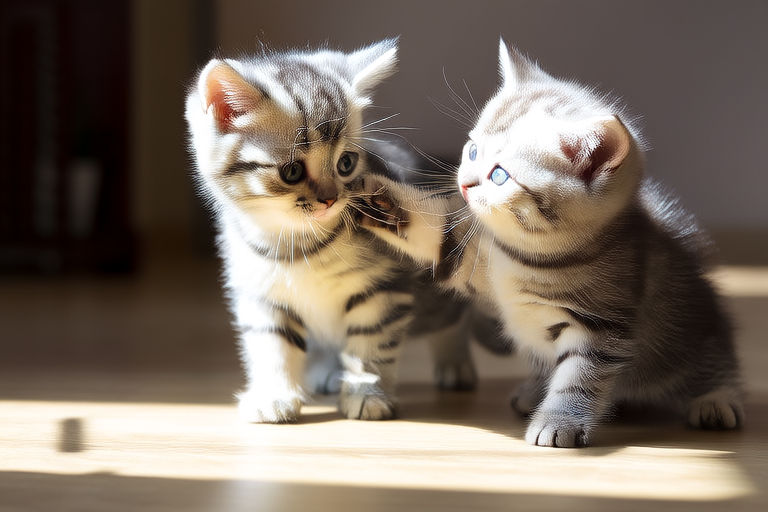Adorable American Shorthair Kittens: A Complete Care Guide
Introduction
Welcome to the wonderful world of American Shorthair kittens! These charming felines have been captivating hearts for centuries with their friendly demeanor and striking appearance. This comprehensive guide will walk you through everything you need to know about caring for your American Shorthair kitten, from understanding their origins and history to ensuring they remain healthy and happy throughout their lives.
Origin and History
The American Shorthair is one of America’s oldest pedigreed breeds, tracing its roots back to the early settlers who brought domestic cats over from Europe. These cats were initially used as working cats on ships and farms, helping to control rodent populations. Over time, they adapted to various environments and developed distinct physical traits that made them ideal companions. By the late 19th century, breeders began selectively breeding these cats, focusing on enhancing desirable characteristics such as robust health, gentle temperaments, and beautiful coats. Today, the American Shorthair remains popular among pet owners worldwide due to its reliability, adaptability, and affectionate nature.
Physical Characteristics
American Shorthair kittens boast a sturdy build and medium-to-large size, making them strong yet graceful. Their heads are rounded with prominent cheeks and wide-set eyes that can be green, blue, or copper-colored. The ears are moderately sized and positioned well apart. One of the most notable features of this breed is its short, dense coat, which comes in an array of colors including silver tabby, brown tabby, black, white, red, cream, and more. The coat’s texture varies depending on age; younger kittens may have softer fur compared to adults. Proper grooming helps maintain their coat’s luster while preventing matting.
Temperament
American Shorthair kittens are known for being calm, friendly, and sociable. They tend to get along well with other pets and children, making them excellent family pets. These cats enjoy interactive play but also appreciate quiet moments where they can relax in laps or near their humans. Their laid-back personalities make them adaptable to different living situations, whether it’s a bustling household or a peaceful apartment setting. Socialization at an early age ensures that your kitten grows up to be confident and well-adjusted.
Dietary Needs
Proper nutrition is crucial for the growth and development of young American Shorthair kittens. High-quality kitten food rich in protein, vitamins, and minerals should form the foundation of their diet. Consult your veterinarian about specific nutritional requirements based on your kitten’s age, weight, and activity level. Fresh water should always be available, encouraging hydration. Avoid feeding human foods that could be harmful, such as chocolate, onions, garlic, grapes, raisins, and alcohol. Gradually transition adult cat food around six months of age when advised by your vet.
Grooming Tips
Regular grooming keeps your American Shorthair kitten looking its best while promoting skin health. Brush their coat weekly using a soft-bristled brush or rubber mitt to remove loose hairs and prevent matting. Bathing is generally unnecessary unless absolutely required, but if needed, use a mild shampoo formulated for cats. Pay attention to areas prone to tangles, especially behind the ears and under the chin. Trim nails regularly to prevent overgrowth, which can cause discomfort or injury. Clean ears gently with a cotton ball dipped in ear-cleaning solution recommended by your vet.
Health Concerns
Like all breeds, American Shorthair kittens can be susceptible to certain health issues. Common problems include dental disease, obesity, and respiratory infections. Regular veterinary check-ups help monitor overall health and address any potential concerns promptly. Vaccinations protect against diseases like rabies, feline leukemia virus (FeLV), and feline immunodeficiency virus (FIV). Parasite prevention measures include regular flea treatments and deworming as prescribed by your veterinarian. Early intervention is key to managing these conditions effectively.
Exercise Requirements
Physical activity promotes good health and mental stimulation for American Shorthair kittens. Provide toys designed for chasing, pouncing, and batting to encourage active play sessions. Interactive games involving laser pointers or feather wands engage both body and mind. Consider creating vertical spaces like cat trees or shelves where they can climb and explore. Indoor enrichment activities mimic natural behaviors while keeping them entertained indoors. Monitor exercise levels closely to ensure they stay within a healthy range without becoming overly energetic.
Training Methods
Training helps establish boundaries and teaches positive behaviors. Positive reinforcement techniques using treats, praise, and clicker training work best with kittens. Teach basic commands such as “sit,” “stay,” and “come” through consistent repetition and reward-based learning. Encourage scratching on appropriate surfaces rather than furniture by providing scratching posts covered in materials they prefer, such as sisal rope or cardboard. Redirect unwanted behavior gently but firmly until desired actions become habitual. Patience and consistency are essential when teaching new skills.
Suitable Environments
American Shorthair kittens thrive in environments that offer comfort, safety, and stimulation. Indoor living provides protection from outdoor hazards while allowing close supervision. Create designated spaces with cozy beds, litter boxes, and feeding areas away from high-traffic zones. Ensure windows have secure screens to prevent accidental falls. Outdoor access should only occur under direct supervision or through enclosed enclosures designed specifically for cats. Safe exploration opportunities within controlled settings support healthy development.
Socializing Them
Early socialization fosters confidence and friendliness towards people and other animals. Expose your kitten gradually to various stimuli such as different sounds, textures, and sights during critical socialization periods between two to seven weeks old. Introduce them gently to other pets after ensuring compatibility through supervised interactions. Familiarize them with common household items like vacuum cleaners, hair dryers, and doorbells to reduce fear responses later in life. Consistent exposure to diverse experiences builds resilience and adaptability.
Conclusion
Raising an American Shorthair kitten requires dedication, love, and attention to detail. By following this complete care guide, you’ll provide your furry friend with everything necessary for a long, healthy, and joyful life together. Remember that every kitten is unique, so tailor your approach based on individual needs and preferences. Enjoy each moment of their growth journey, cherishing the bond formed between owner and beloved companion.
